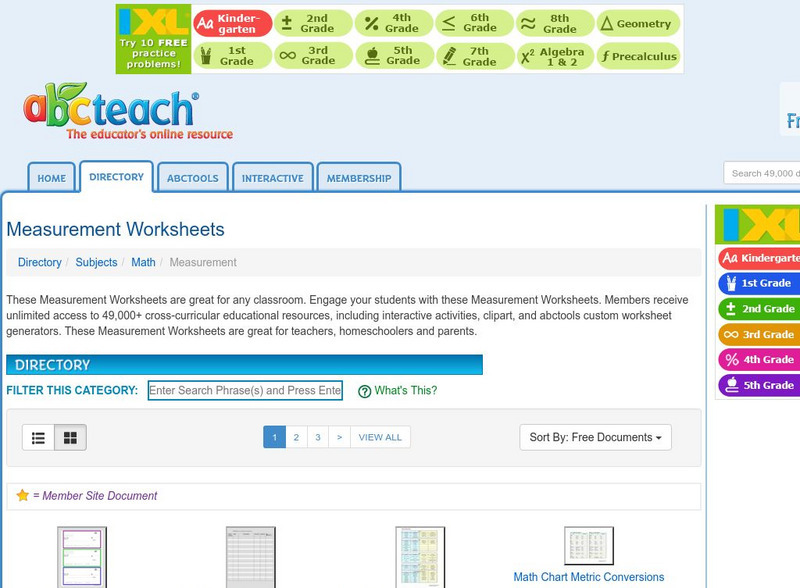Hi, what do you want to do?
Curated OER
Jupiter's Moons
Students predict which of Jupiter's moons will be the "brightest" in infrared wavelengths. Using provided information, they rank the moos from brightes to faintest in infrared.
Curated OER
Classifying Candy III
Students create a classification tree based on grouping candy with eight different properties. This allows students to understand how living things are classified.
Curated OER
Bugsicles (A Frozen Insect Larva You can Find!)
Learners explore how animals survive in the winder. After attending a gall-collecting field trip, students place them in a freezer. Once frozen, the learners open the gall flay larva and observe it as the larva revives. Students...
Curated OER
Pollen Tube Growth
High schoolers demonstrate the proper usage of the compound and dissecting microscopes. They identify the parts of a flower and the functions of the flower parts. Students describe the process of gamete formation and fertilization in a...
Curated OER
Recycling Garden Waste
Students experience how to make compost. This lesson plan is ongoing with periodic checks and maintenance. They select a piece of ground around the school or around their homes to establish a compost pile. Organic materials are utilized...
Curated OER
Persistence Forecasting
Students study weather forecasting. In this weather lesson, students explore forecasting weather methods and do a forecast. Students study weather reports and discuss the elements of a forecast. Students study the method of persistence...
Curated OER
Grow Your Own Grub
Young scholars study plant needs and growth by completing a gardening activity. In this plant study lesson, students watch a video and discuss plant growth needs. Young scholars plant seeds in containers and water the plants. Students...
University of Illinois
University of Illinois Extension: Tree House Weather Kids: Seasons and Temperature: How Do We Measure Temperature?
Animated interactive teaches young researchers about scales and devices used to measure temperature.
BBC
Bbc Skillswise: Measuring: Temperature
Information about reading and comparing temperature in Fahrenheit and Celsius.
AAA Math
Aaa Math: All About Measurements
A complete tutorial that explains time, metric system, mass, length, volume, and temperature. Interactive practices and challenge games are included.
Cuemath
Cuemath: Temperature
The article explains temperature. Specifically, you will learn about the temperature scale, temperature scale conversions, and the types of instruments used to measure temperature. Included are solved examples and interactive problems...
Math Is Fun
Math Is Fun: Conversion of Temperature: Celsius to Fahrenheit
Learn about the two main temperature scales, Celsius and Fahrenheit, and how to convert temperature from one to another. View two conversion examples and a chart of typical temperatures, and use the conversion tool.
TeachEngineering
Teach Engineering: Make Your Own Temperature Scale
Students learn about the difference between temperature and thermal energy. They build a thermometer using simple materials and develop their own scale for measuring temperature. They compare their thermometer to a commercial...
CK-12 Foundation
Ck 12: Kinetic Theory of Temperature
[Free Registration/Login may be required to access all resource tools.] In this online lesson students will be introduced to conditions required for an ideal gas. They will also learn about the similarities and differences between...
E-learning for Kids
E Learning for Kids: Math: Group of Pyramids: Polygons and Temperature
Learn about 2D shapes and temperature with King Toot.
abcteach
Abcteach: Math: Measurement
[Free Registration/Login Required] Teachers will find a variety of worksheets, booklets, conversion charts, warm-up activities and more on measurements. There is even one activity that could be used in a French language class which...
Texas Education Agency
Texas Gateway: Temperature
Read and view examples and formulas about temperature, its measurement by thermometers, and its relationship to thermal equilibrium.
Mocomi & Anibrain Digital Technologies
Mocomi: Fun Facts About Temperature
Learn about units of temperature and other interesting facts.
NASA
Nasa: Trends of Snow Cover and Temperature in Alaska
This lesson plan allows students to use NASA satellite data observations with surface measurements of snow in Alaska. Students will be able to make scientific predictions, find data correlations, and learn about data collection methods.
Physics Classroom
The Physics Classroom: Thermal Physics: Measuring the Quantity of Heat
Through interactive exercises and illustrated example problems, students learn about specific heat capacity and measuring the quantity of heat.
E-learning for Kids
E Learning for Kids: Science: Atlantic Ocean: What Is Temperature?
Students learn the difference between heat and temperature, how temperature is measured, and about the Celsius scale.
PBS
Pbs Kids Afterschool Adventure!: Operation: Dog House Design Activity Plan
Children will learn about and explore measurement to successfully design a dog house for his or her cutout paper dog. Each section of this weeklong adventure is introduced by a video clip or online game that encourages children to...
Science4Fun
Science4 Fun: Temperature
Discover interesting facts about temperature and learn the different ways it is measured.
New York University
New York University: Measurement of Energy
Provides information about the distinction between heat and temperature, and allows you to check your understanding through exercises. The Kelvin, Fahrenheit, and Celsius temperatures are compared and discussed.
























